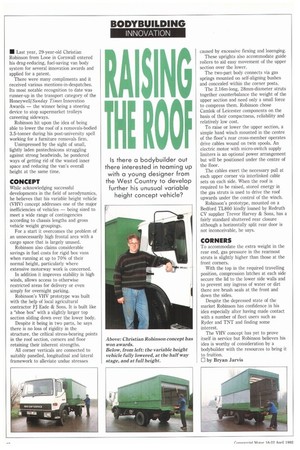RAISING I
Page 44

If you've noticed an error in this article please click here to report it so we can fix it.
Is there a bodybuilder out there interested in teaming up with a young designer from the West Country to develop further his unusual variable height concept vehicle?
IN Last year, 29-year-old Christian Robinson from Looe in Cornwall entered his drag-reducing, fuel-saving van body system for several innovation awards and applied for a patent.
There were many compliments and it received various mentions-in-despatches. Its most notable recognition to date was runner-up in the transport category of the Honeywell/Sunday Times Innovation Awards — the winner being a steering device to stop supermarket trolleys careering sideways.
Robinson hit upon the idea of being able to lower the roof of a removals-bodied 3.5-tonner during his post-university spell working for a furniture removals firm.
Unimpressed by the sight of small, lightly laden pantechnicons struggling against strong headwinds, he pondered ways of getting rid of the wasted inner space and reducing the van's overall height at the same time.
CONCEPT
While acknowledging successful developments in the field of aerodynamics, he believes that his variable height vehicle (VHV) concept addresses one of the major inefficiencies of vehicles — being sized to meet a wide range of contingencies according to chassis lengths and gross vehicle weight groupings.
For a start it overcomes the problem of an unnecessarily high frontal area with a cargo space that is largely unused.
Robinson also claims considerable savings in fuel costs for rigid box vans when running at up to 70% of their normal height, particularly where extensive motorway work is concerned.
In addition it improves stability in high winds, allows access to otherwise restricted areas for delivery or even simply for overnight parking.
Robinson's VHV prototype was built with the help of local agricultural contractor FJ Eade & Sons. It is built like a "shoe box" with a slightly larger top section sliding down over the lower body.
Despite it being in two parts, he says there is no loss of rigidity in the structure, the critical stress-bearing points in the roof section, corners and floor retaining their inherent strengths.
All corner verticals are connected to suitably panelled, longitudinal and lateral framework to alleviate undue stresses Above: Christian Robinson concept has won awards.
Below, from left: the variable height vehicle fully lowered, at the half way stage, and at full height. caused by excessive flexing and lozenging. These uprights also accommodate guide rollers to aid easy movement of the upper section over the lower.
The two-part body connects via gas springs mounted on self-aligning bushes and concealed within the corner posts.
The 2.1 6m-long, 28mm-diameter struts together counterbalance the weight of the upper section and need only a small force to compress them. Robinson chose Camlok of Leicester components on the basis of their compactness, reliability and relatively low cost.
To raise or lower the upper section, a simple hand winch mounted in the centre of the floor's rear cross-member operates drive cables wound on twin spools. An electric motor with micro-switch supply limiters is an optional power arrangement but will be positioned under the centre of the floor.
The cables exert the necessary pull at each upper corner via interlinked cable sets on each side. When the roof is required to be raised, stored energy in the gas struts is used to drive the roof upwards under the control of the winch.
Robinson's prototype, mounted on a Bedford TL860 kindly loaned by Redruth CV supplier Trevor Harvey & Sons, has a fairly standard shuttered rear closure although a horizontally split rear door is not inconceivable, he says.
CORNERS
To accommodate the extra weight in the rear end, gas pressure in the rearmost struts is slightly higher than those at the front corners.
With the top in the required travelling position, compression latches at each side secure the lid to the lower side walls and to prevent any ingress of water or dirt there are brush seals at the front and down the sides.
Despite the depressed state of the market Robinson has confidence in his idea especially after having made contact with a number of fleet users such as Ryder and TNT and finding some interest.
The VHV concept has yet to prove itself in service but Robinson believes his idea is worthy of consideration by a bodybuilder with the resources to bring it to fruition.
El by Bryan Jarvis




































































































